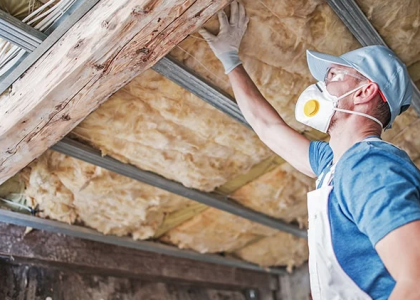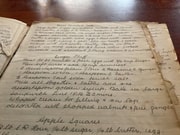Doctors discover thousands of 'sesame seed' lesions in a woman's body decades after she built a garage with her dad
By
VanessaC
- Replies 3
Many have fond memories of building things with their parents when they were kids, whether it be a small piece of furniture or an extension of the house.
But for one woman born in the 1960s, helping her father build a project provided more than just a special father-daughter bond—it would later lead to a severe health crisis.
In the mid-1960s, a young Lisa Hoggard stood by her father's side, assisting him in building a garage.
The air was filled with fine grey-blue dust, a byproduct of the fast-spinning blades of his bench saw cutting through the latest must-have construction material—asbestos.
Little did they know that this seemingly harmless dust would become a ticking time bomb in Lisa's body, leading to a devastating diagnosis nearly six decades later.
Asbestos, a naturally occurring mineral, was once hailed as a miracle material for its durability, fire and water resistance, and ease of use.
However, its deadly nature was revealed years later, with the microscopic fibres capable of causing severe lung diseases, including mesothelioma, a rare and aggressive form of cancer.
Fast forward to 2020, Lisa, now 62, began experiencing moderate abdominal pain which her GP initially dismissed.
It wasn't until she moved to the serene NSW Southern Highlands that her new doctor took her symptoms seriously.
'I went in on a Friday and explained my abdomen was hurting,' Lisa recalled.
'She (the doctor) told me, if it was still there on Monday, to come back.'
Lisa headed back to her doctor, and a series of tests and examinations led to a shocking discovery—a tumour in Lisa's abdomen.
Within a fortnight, she was booked for surgery.
'Two weeks isn’t a lot of time to think, so it was great,' she said.
'But at the same time, I was thinking I had cancer, and it wasn’t going to be good.'
The tumour turned out to be benign, but the exploratory operation revealed something far more sinister.
Lisa's abdomen was riddled with numerous abnormalities, likened to scattered sesame seeds.
Multiple biopsies confirmed the worst—Lisa had papillary peritoneal mesothelioma, a rare form of mesothelioma caused by asbestos exposure.
The news was a devastating blow. Lisa was all too familiar with the disease, having watched Australian builder Bernard 'Bernie' Banton's public battle with peritoneal mesothelioma in the early 2000s.
Banton became the face of asbestos-related disease as he fought for compensation for sufferers of cancers caused by asbestos products. He lost his fight in 2007.
'I just joined the dots and knew there was no cure,' Lisa said.
'I was blindingly terrified.'
As Lisa grappled with her diagnosis, her family pieced together her history of asbestos exposure.
As a child, she had helped her father build a garage and a small extension using asbestos materials.
The memory of young Lisa covered from head to toe in the cancer-causing blue dust was a chilling reminder of the deadly legacy of asbestos.
However, Lisa's health challenges didn't end there.
A full body scan revealed another blow—she also had breast cancer.
Compared to the mesothelioma battle that lay ahead, Lisa regarded the breast cancer and its treatments as a mere 'hiccup'.
She underwent a gruelling 12-hour surgery, where she would be cut open from her sternum to her pubic bone.
She was then put through a 'hot chemotherapy wash' where surgeons pumped 'hot chemotherapy' into Lisa's body and 'sloshed it around'.
The surgery was a success and Lisa was discharged 17 days later.
After six months of recovery, Lisa's cancer hasn't returned.
Today, Lisa is a survivor and has retired, filling her days with gardening, motorbike riding, and mentoring.
She considers the benign tumour in her abdomen a 'happy coincidence', as its discovery led to the early detection of her mesothelioma and breast cancer.
'Without the tumour, they may have never found the peritoneal mesothelioma, or maybe even my breast cancer,' she said.
Lisa's story is a testament to the importance of early detection and the need for continued research into asbestos-related diseases. She is sharing her journey in support of the Asbestos and Dust Disease Research Institute’s new podcast series Dust Disease Diaries, which aims to raise awareness and provide support for those affected by asbestos-related diseases.
Meanwhile, as the 20th anniversary of Australia's ban on asbestos approaches, homeowners and do-it-yourself renovators are being reminded of the health risks associated with this hazardous material.
Asbestos is reportedly responsible for approximately 4,000 deaths each year from cancer and other asbestos-related diseases—three times the national road toll.
Despite the ban on asbestos in December 2003, the risks associated with this material are far from over.
The risk of exposure and environmental contamination is also heightened by frequent extreme weather events, such as floods and fires, which can damage structures and release asbestos fibres into the air.
You can read more about this warning here.

Have you or a loved one been affected by asbestos exposure? Share your experiences with us in the comments below.
But for one woman born in the 1960s, helping her father build a project provided more than just a special father-daughter bond—it would later lead to a severe health crisis.
In the mid-1960s, a young Lisa Hoggard stood by her father's side, assisting him in building a garage.
The air was filled with fine grey-blue dust, a byproduct of the fast-spinning blades of his bench saw cutting through the latest must-have construction material—asbestos.
Little did they know that this seemingly harmless dust would become a ticking time bomb in Lisa's body, leading to a devastating diagnosis nearly six decades later.
Asbestos, a naturally occurring mineral, was once hailed as a miracle material for its durability, fire and water resistance, and ease of use.
However, its deadly nature was revealed years later, with the microscopic fibres capable of causing severe lung diseases, including mesothelioma, a rare and aggressive form of cancer.
Fast forward to 2020, Lisa, now 62, began experiencing moderate abdominal pain which her GP initially dismissed.
It wasn't until she moved to the serene NSW Southern Highlands that her new doctor took her symptoms seriously.
'I went in on a Friday and explained my abdomen was hurting,' Lisa recalled.
'She (the doctor) told me, if it was still there on Monday, to come back.'
Lisa headed back to her doctor, and a series of tests and examinations led to a shocking discovery—a tumour in Lisa's abdomen.
Within a fortnight, she was booked for surgery.
'Two weeks isn’t a lot of time to think, so it was great,' she said.
'But at the same time, I was thinking I had cancer, and it wasn’t going to be good.'
The tumour turned out to be benign, but the exploratory operation revealed something far more sinister.
Lisa's abdomen was riddled with numerous abnormalities, likened to scattered sesame seeds.
Multiple biopsies confirmed the worst—Lisa had papillary peritoneal mesothelioma, a rare form of mesothelioma caused by asbestos exposure.
The news was a devastating blow. Lisa was all too familiar with the disease, having watched Australian builder Bernard 'Bernie' Banton's public battle with peritoneal mesothelioma in the early 2000s.
Banton became the face of asbestos-related disease as he fought for compensation for sufferers of cancers caused by asbestos products. He lost his fight in 2007.
'I just joined the dots and knew there was no cure,' Lisa said.
'I was blindingly terrified.'
As Lisa grappled with her diagnosis, her family pieced together her history of asbestos exposure.
As a child, she had helped her father build a garage and a small extension using asbestos materials.
The memory of young Lisa covered from head to toe in the cancer-causing blue dust was a chilling reminder of the deadly legacy of asbestos.
However, Lisa's health challenges didn't end there.
A full body scan revealed another blow—she also had breast cancer.
Compared to the mesothelioma battle that lay ahead, Lisa regarded the breast cancer and its treatments as a mere 'hiccup'.
She underwent a gruelling 12-hour surgery, where she would be cut open from her sternum to her pubic bone.
She was then put through a 'hot chemotherapy wash' where surgeons pumped 'hot chemotherapy' into Lisa's body and 'sloshed it around'.
The surgery was a success and Lisa was discharged 17 days later.
After six months of recovery, Lisa's cancer hasn't returned.
Today, Lisa is a survivor and has retired, filling her days with gardening, motorbike riding, and mentoring.
She considers the benign tumour in her abdomen a 'happy coincidence', as its discovery led to the early detection of her mesothelioma and breast cancer.
'Without the tumour, they may have never found the peritoneal mesothelioma, or maybe even my breast cancer,' she said.
Lisa's story is a testament to the importance of early detection and the need for continued research into asbestos-related diseases. She is sharing her journey in support of the Asbestos and Dust Disease Research Institute’s new podcast series Dust Disease Diaries, which aims to raise awareness and provide support for those affected by asbestos-related diseases.
Meanwhile, as the 20th anniversary of Australia's ban on asbestos approaches, homeowners and do-it-yourself renovators are being reminded of the health risks associated with this hazardous material.
Asbestos is reportedly responsible for approximately 4,000 deaths each year from cancer and other asbestos-related diseases—three times the national road toll.
Despite the ban on asbestos in December 2003, the risks associated with this material are far from over.
The risk of exposure and environmental contamination is also heightened by frequent extreme weather events, such as floods and fires, which can damage structures and release asbestos fibres into the air.
You can read more about this warning here.
Key Takeaways
- Lisa Hoggard was diagnosed with papillary peritoneal mesothelioma, a deadly cancer caused by asbestos exposure, which she unknowingly came in contact with as a child helping her father in the garage.
- She initially experienced abdominal pain and was later diagnosed with breast cancer during her body scan for mesothelioma treatment.
- Lisa underwent a 12-hour surgery involving a 'hot chemotherapy wash', which was ultimately successful, and her cancer hasn't returned since.
- Now retired, she shares her story in support of the Asbestos and Dust Disease Research Institute’s new podcast series Dust Disease Diaries and believes the discovery of a benign abdominal tumour saved her life by leading to the early detection of her other conditions.
Last edited:








